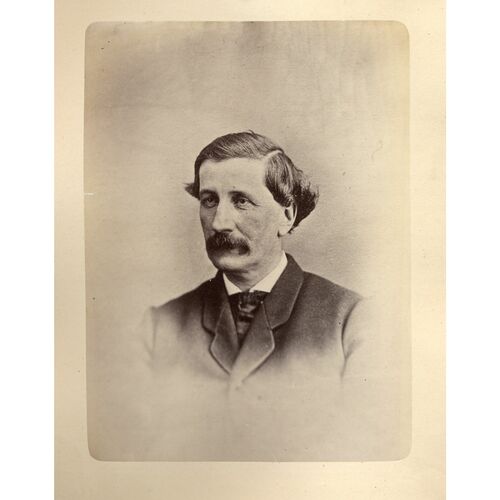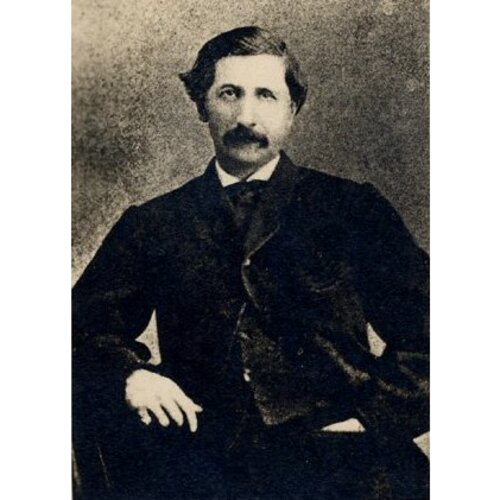LAFRAMBOISE, MAURICE (baptized Maurice-Alexis), lawyer, politician, newspaper proprietor, and judge; b. 18 Aug. 1821 at Montreal, Lower Canada, son of Alexis Laframboise, a merchant, and Lucie-Angélique, daughter of Gabriel Cotté*; d. 1 Feb. 1882 at Montreal.
After classical studies at the Petit Séminaire de Montréal from 1831 to 1840, Maurice Laframboise articled in law and was called to the bar on 9 Dec. 1843. He settled at Saint-Hyacinthe and in 1846 married Rosalie, daughter of the seigneur Jean Dessaulles* and Rosalie Papineau, sister of Louis-Joseph*. Laframboise attended to the affairs of the Dessaulles seigneury until 1852 at which time the seigneury was divided among the Dessaulles children, Louis-Antoine*, the eldest, receiving half, and Rosalie and Georges-Casimir a quarter each.
Laframboise practised law at Saint-Hyacinthe in partnership with both Jean-Baptiste Bourgeois and Augustin-Cyrille Papineau, son of Denis-Benjamin Papineau*. From 1857 to 1860 he was mayor of Saint-Hyacinthe, succeeding his brother-in-law Louis-Antoine Dessaulles who had held the office since the town’s incorporation in 1849. Laframboise ran for the Liberals in the general elections of 1857–58 and was elected in Bagot, the county adjoining Saint-Hyacinthe, where Dessaulles, an important member of the Rouges, had lost by a narrow margin in 1854. Re-elected in the general elections of 1861 and 1863, Laframboise had to go to the polls again in the latter year after accepting the post of commissioner of public works in the government of John Sandfield Macdonald* and Antoine-Aimé Dorion*; he received 58 per cent of the votes, defeating Dr Jean-Baptiste Desrosiers, the brother-in-law of George-Étienne Cartier*. The Macdonald-Dorion government had to give up office in the spring of 1864 and on 29 March Laframboise left his post. That same year the Laframboise family left Saint-Hyacinthe for Montreal.
As an opposition member, Laframboise was one of the most important opponents of confederation, and therefore belonged to the Saint-Jean-Baptiste Club [see Ludger Labelle*] as did Médéric Lanctot*, the editor of L’Union nationale, and Joseph-François Perrault and Alexandre Dufresne, members of the assembly for Richelieu and for Iberville. Laframboise delivered major speeches about confederation during the debates in the house in 1865. He argued that a question of this magnitude must be referred to the people, that the authority of a central government and the addition of the Maritime provinces would be dangerous for the “religion,” “nationality,” and “institutions of Lower Canada,” and that the plan of confederation was consistent with the means outlined in the report of Lord Durham [Lambton*] for “the annihilation of French nationality in this country.”
In the federal elections which followed confederation in 1867, Laframboise, standing as the Liberal candidate in Bagot County, polled 43 per cent of the votes and had to concede defeat to Pierre-Samuel Gendron. Despite this reverse he remained influential in the Liberal party. In the provincial elections of 1871 he campaigned with Liberal members Pierre Bachand* and Félix-Gabriel Marchand* (elected in 1867 for Saint-Hyacinthe and Saint-Jean) in the Yamaska and Richelieu region, and was himself elected in Shefford. At the end of 1871, when the Parti National was formed, largely by moderate Liberals and a few Conservatives, and when Le Pays, a newspaper still associated with the Rouges, ceased publication, Laframboise laboured to establish Le National to provide a voice for the new movement. Its first issue appeared on 24 April 1872 and he became its owner-publisher. Laframboise and the paper’s editor, Charles Laberge*, a former contributor to L’Ordre, made it their policy to defend the position of the “Nationaux” and of the moderate Liberals.
In the assembly, Laframboise and other Liberals declared themselves in favour of both reform of the electoral law and commercial and industrial training. At the same time he took an interest in the economic development of the Saint-Hyacinthe region, where it was felt in business circles that progress would come through industry and railways. In 1872 he was one of the promoters of the Philipsburg, Farnham and Yamaska Railway, but the project eventually failed. With his brother-in-law, Georges-Casimir Dessaulles, who was the town’s mayor, and Pierre Bachand, he was a principal shareholder of the Maison de Banque R. St-Jacques et Cie, a limited partnership formed to “trade in money” at Saint-Hyacinthe; in 1873 the firm was incorporated as the Banque de Saint-Hyacinthe.
With the provincial elections of 1875 approaching, the Liberals, to counterbalance the Club Cartier of the Conservatives, founded in Montreal the Club National where politics were discussed and publicity campaigns organized. Laframboise gave a library to the club, which primarily brought young people together. That year Conservative newspapers alleged that Liberal leaders, in particular Toussaint-Antoine-Rodolphe Laflamme* and Louis-Amable Jetté* but also Laframboise, had attempted to take advantage of a plan to enlarge the Lachine Canal in 1874 and of the Liberal party’s being in power in Ottawa to profit from a speculation (the so-called “Lachine Canal job”). Laframboise was nevertheless re-elected unopposed for Shefford.
Maurice Laframboise was mentioned as a candidate for the lieutenant governorship of Quebec when René Édouard Caron* died on 13 Dec. 1876, but Luc Letellier de Saint-Just was chosen. Similarly his name came up for the post of lieutenant governor of Manitoba before the appointment of Joseph-Édouard Cauchon. When Letellier brought about the resignation of the provincial Conservative government of Charles-Eugène Boucher* de Boucherville in 1878, the Liberal leader, Henri-Gustave Joly*, did not select Laframboise for his cabinet, but it was the latter who announced the composition of the Liberal government in the Legislative Assembly. At that time Laframboise aspired to become speaker of the house; disappointed, he then entertained thoughts of succeeding Letellier as lieutenant governor, but once again his hopes were dashed.
However, before resigning at the end of 1878 the government of Alexander Mackenzie* appointed Laframboise judge of the Superior Court for the Gaspé district. On 22 Feb. 1879 Le National, which was now in financial difficulty, published its last issue and the cause of Liberal journalism in Montreal was taken up by Honoré Beaugrand* in La Patrie. Maurice Laframboise died on 1 Feb. 1882 in Montreal at the age of 60.
Laframboise had six children. One of his daughters married Louis-Onésime Loranger, attorney general in the Quebec government of Pierre-Joseph-Olivier Chauveau, and one of his sons, Jules, was manager of the Canadian Bank of Commerce at Saint-Hyacinthe from 1895 to 1924.
For many years the Parc Laframboise, with its racetrack, reminded the citizens of Saint-Hyacinthe that Maurice Laframboise had been the first to promote the Turf Club, which had attracted to the town British officers stationed in Montreal until 1871 as well as members of the important families of the region.
ANQ-M, État civil, Catholiques, Notre-Dame de Montréal, 18 août 1821. PAC, MG 30, D1, 17: 304–6. Can., Prov. du, Parl., Débats parl. sur la confédération. Gazette (Montreal), 2 Feb. 1882. Le Journal de Saint-Hyacinthe (Saint-Hyacinthe, Qué.), 13 août 1863. La Minerve, 2 févr. 1882. Montreal Herald and Daily Commercial Gazette, 2 Feb. 1882. L’Opinion publique, 28 nov. 1878, 9 févr. 1882. Beaulieu et J. Hamelin, La presse québécoise, II: 188–89. J. Desjardins, Guide parl. Dominion annual register, 1882. P.-G. Roy, Les juges de la prov. de Québec, 70–71, 290–91, 424–25. Album souvenir; St-Hyacinthe, 1748–1948 (s.l., s.d.), 69, 99. J.-P. Bernard, “La pensée des journalistes libéraux de Saint-Hyacinthe, 1853–1864” (thèse de ma, univ. de Montréal, 1958); Les Rouges, 146–50, 188–92, 221, 225–30, 233–34, 295–311. C.-P. Choquette, Histoire de la ville de Saint-Hyacinthe (Saint-Hyacinthe, 1930), 58, 262–69, 413–14, 474–75. M. Hamelin, Premières années du parlementarisme québécois, 122–31, 194–95, 210–11, 218–21, 232–33, 252, 276, 304, 309. Laurent Lapointe, “La formation de la Banque de St-Hyacinthe et le développement économique régional (1850–1875)” (thèse de ma, univ. de Montréal, 1976), 102, 131. Rumilly, Hist. de la prov. de Quebec, I: 51, 53–54, 193, 196, 205, 207, 216; II: 17, 63, 94, 108, 134–35, 165, 177; III: 149; Hist. de Montréal, II: 381;III: 28–29, 64–67, 92–93, 97. É.-Z. Massicotte, “Une société politique secrète à Montréal; le Club Saint-Jean-Baptiste,” BRH, 21 (1915): 134–38.
Cite This Article
Jean-Paul Bernard, “LAFRAMBOISE, MAURICE (baptized Maurice-Alexis),” in Dictionary of Canadian Biography, vol. 11, University of Toronto/Université Laval, 2003–, accessed November 7, 2024, https://www.biographi.ca/en/bio/laframboise_maurice_11E.html.
The citation above shows the format for footnotes and endnotes according to the Chicago manual of style (16th edition). Information to be used in other citation formats:
| Permalink: | https://www.biographi.ca/en/bio/laframboise_maurice_11E.html |
| Author of Article: | Jean-Paul Bernard |
| Title of Article: | LAFRAMBOISE, MAURICE (baptized Maurice-Alexis) |
| Publication Name: | Dictionary of Canadian Biography, vol. 11 |
| Publisher: | University of Toronto/Université Laval |
| Year of publication: | 1982 |
| Year of revision: | 1982 |
| Access Date: | November 7, 2024 |


![[Honorable Maurice Laframboise] [image fixe] / Studio of Inglis Original title: [Honorable Maurice Laframboise] [image fixe] / Studio of Inglis](/bioimages/w600.4804.jpg)


